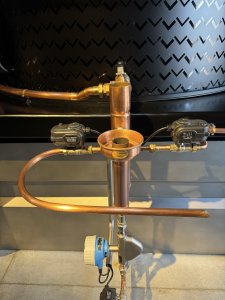Egg-sperimental whisky: Maison Lineti
Hello strangers. It seems appropriate at Easter to break from a disgracefully long – book induced – absence to wander around the egg box in St.Emilion which is home to Maison Lineti
Read on…
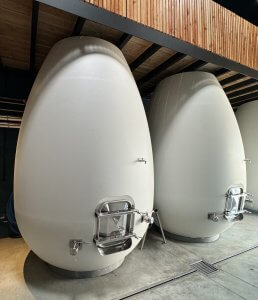
For years, the different worlds of wines and spirits were kept separate apart from Cognac and Armagnac which were tolerated by the wine police because they were made from grapes. Maybe this is just me being paranoid, but in those days you got the feeling that spirits were ‘trade’, while wine has class. Never should the twain meet. Thankfully, that that boundary is steadily eroding and the question, what can wine add to whisky, is being asked. Not in terms of casks for finishing (something which is mostly clumsily done), but a deeper exchange.
This is why I’m driving with Magali Picard through the vineyards of Pomerol and St.Emilion to see a whisky distillery. We pass dark gnarly vines, the occasional person pruning, a man with a horse and plough, stubby modest wineries which seem to rise from the earth. Not exactly classic whisky country.
Some background. Magali, her husband Alex Cosculluela, and Xavier Payan founded Maison Lineti (it’s an anagram of Saint Emilion) in 2020. She has a doctorate in oenology and for the past five years has been heading the research department at Tonnellerie Demptos. Want to know anything about oak? Ask her.
Alex, who has an MSc in wine and spirits, met Xavier at Bordeaux’s Kedge business school. Xavier then went to work for JM Cazes, owner of Châteaux Lynch-Bages (and others). All believed in a new interpretation of whisky, one influenced and guided by wine. With investment from the Thienpont family (owners of Vieux Château-Certan, Le Pin and a host of others) the first spirit arrived in 2022.
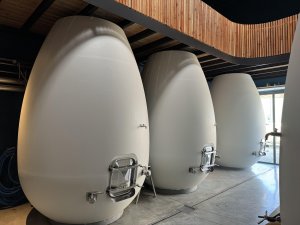
It is made from organic barley (more common in France than Scotland) malted for Maison Lineti’s by Soufflet. As became apparent as the day progressed, jut buying malted barley was not enough. For the team there’s always some other detail to be explore. Everything here is being questioned and analysed.
‘The malt is of good quality,’ says Magali, ‘but our aim is for a spirit that has floral characters, minerality, suppleness, and tension. We think that we can increase the floral character during the malting process, so we’re working with Soufflet on a bespoke regime.’
The minerality, Alex explains, comes from the aquifer 300m below the distillery. ‘The water’s high in calcium and sodium – that’s also good for developing the floral character. We’ve adapted our process to the water, not the other way around.’ It’s a break with the convention i whisky which states that water makes no difference.
The most dramatic break from the norm is in fermentation. Instead of the usual wooden or stainless steel tanks it takes place in seven tall white ceramic eggs. ‘We’re looking interaction between the lees and the wash,’ he says. ‘The egg shape creates thermal currents which moves the lees around, giving greater lees interaction’ he continues. It also keeps the temperature at 28˚ which in turn optimises the yeast we’re using.’ This churn is allowed to carry on for a week.
Now, lees is not a term used in whisky, but in wine it refers to the the dead yeast cells left after fermentation. Leaving them in contact with the wine releases amino acids and some sugars, giving the wine a thicker texture. As whisky has lees, why not use them in the same way?
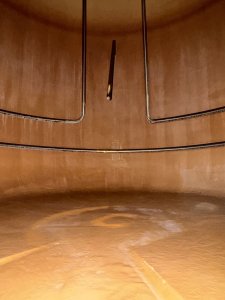
Keen to explore more, this year they’ve been dropping the temperature to 7˚C after the week-long ferment and leaving the wash on lees for a further fortnight. Because of the low temperature, there’s no more movement within the egg, so the lees are pumped over each day. It’s a wine thing. Get over it. ‘We love lees in France!’ he laughs. ‘They give fatness. It’s common in wine… just not in whisky …’ He smiles, shrugs. ‘Everything is being done for aromatics and feel.’
It would be rude not to taste some wash. At five days, there’s some floral elements, even pineapple, but also a vibrant, lemony acidity. After two weeks on lees tropical fruits emerge, but the raciness is retained. Here’s the tension Magali was talking about.
‘It’s, how do you say it in English?’ says Alex, pointing to his back.
‘The spine.’
‘Yes. If you are wanting long-lived whisky with character you have to have this spine.’
Tension. You need it in life, let’s face it. To stop things becoming flabby and too comfortable. It’s a good quality to have.
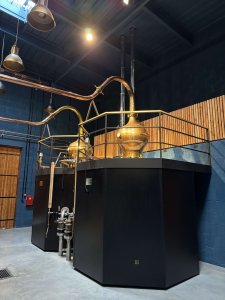
Initially, things appear to return to a degree of normality in the stillhouse with its pair of Charentais-style stills. It’s a design that’s fairly common in French whisky distilleries, not least because a growing number of Cognac producers (where, by law, this design has to be used) are now making whisky in the downtime between the end of the distillation period and the next vintage (by law all Cognac distillation must cease by March 31).
They’re direct fired, the belly of the still encased inside a brick oven with only its curving shoulder showing. It then swells into an onion-shaped head which thins into a slender, curving swan neck.
By now I know there’s going to be some variation on straightforward double distillation. A heads cut is taken in the first distillation which is retained for the next run. The low wines are redistilled and cut into heads, heart, and tail. Again, the heads go back to the next wash distillation.
The heart, diluted, is casked, but the tails are handled differently. In one of the stills, after the cut is taken, the distillation continues to be run slowly – for another six hours. These ‘slow tails’ are then recycled with the next lot of low wines.
The temperature is raised in the other still, producing ‘fast tails’ (the term’s relative, this still takes four hours) which go back to the next wash distillation. The inspiration isn’t wine this time, but an adaptation of a Cognac approach.
Why this extra complication? ‘The slow tails have less undesirable compounds because there’s more reflux,’ explains Magali. ‘Having tails that have been more rectified allows us to extend the cut point for the next distillation. The fast tails are only lightly rectified. This gives us more structure in the wash for the next distillation.’ Structure? More wine speak.
Nearly every distiller around the world these days talks about slowing down distillation to maximise reflux, so it’s surprising when Alex says that they’ve actually sped up the spirit run. I’m confused. Given that the aim is for fruits and flowers, you would imagine that reflux would be maximised.
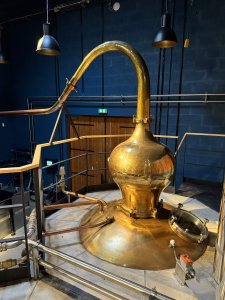
We crouch beside the top of the still. ’Cognac has to be distilled slowly because they might be distilling a wine that’s months old, so you need a lot of reflux to clean things up. When we ran it that way, the result was too light, so we ran the stills faster.’
He reads my mind. ‘We still get massive reflux though. Here,’ he points to the shoulder. ‘Here in the onion, and,’ he stands up, ‘here at the highest point of the swan neck.’ Speed is relative.
It’s a further example of how the Lineti team” isn’t following the whisky tramlines but finding new ways to explore the entire process to get the desired flavour characters. Drawing from wine or Cognac is the right thing to do. What is learning but sharing, trialing and adapting? If it works, great, if it doesn’t, well you’ve still learned something. The important thing is to ask the question – and then keep asking.
We dip glasses into the tank of new make. It’s surprisingly bready, but the light florals are there, along with a central fatness and green fruits which develop with water. Even at this stage, there’s length and finesse, something I’ve noticed in many French whiskies. I have a hunch the Charentais shape has something to do with it, but in whisky you can’t isolate one element and say ‘that’s it!’
Given Magali’s background, there’s little surprise how things manifest themselves in the warehouse. There are different toasts, char levels, sizes of cask and locations. While most of the research revolves around the effect of new French oak on the spirit, there’s ex-Bourbon casks as well as well as some ex-fortified wines. As she puts it, ’20 modalities.’
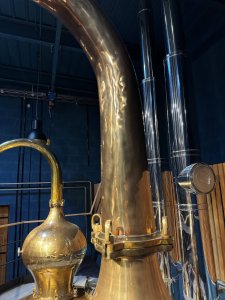
French oak is very interesting,’ she says. ‘It can bring structure and create a foundation for the new make. Its tannins prolong taste, and keep length and tension. Its fine grain plays an important role in oxygenation which also adds to complexity.’
A sample is poured. ‘The cask is called Paradox,’ she says. ‘It’s made from new French oak with a specific heavy toast created with a central chimney that has holes in it. This gives a deep toast, but without any char… it’s a technique used for wine.’ By now that last comment doesn’t surprise me at all.
There’s good oak extract along with stewing fruit, a ripe deep mid-palate, then that acidity.
‘Now try this…’ The cask is labeled ‘Essencia’. ‘It’s also new French oak, but this is pink.’ I wonder if my constant expression of surprise or bewilderment is causing them some doubts as to my fitness for my job.
She smiles. ‘It’s something which appears in some French oaks. You can’t predict where or when it happens. You have to wait until you cut the tree,” This is something which I’ve heard from cabinetmakers and coopers – only when splitting the trunk can you see the full story. But pink oak?
‘It’s rich in carotenoids which are degraded dusting seasoning and toasting at 200-220˚C into compounds like b-ionone and b-damascone,’ she explains. ‘It’s hopefully another type of oak that will help with raising floral and fruity elements.’
‘And make you see in the dark?’ I add to complete bafflement. ‘You know.. carrots.’ Apparently the French don’t believe that carrots help with night vision.
I taste. The florals are certainly heightened, but there’s also a softer flow, gentler tannins, an upping of spice and slightly lower acids.
The difference between new French and ex-Bourbon is more obvious in the next sample when the familiar vanillin and butteriness of the latter oak species appears along with yellow fruit, creme Catalan and a mineral finish.
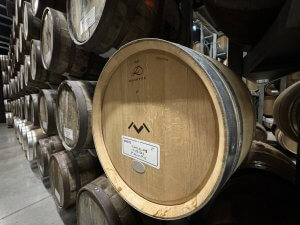
The first of the lees-rested spirit has only been in cask for a few months, but from an new American oak casks is fine-boned, expanding in the mid-palate, thickening into strawberry fruit, lily. The finish remains taut and mineralic.
‘We’ also added lactic to some of the ferments,’ says Magali drawing another sample. Of course they did, Precise, intense, sherbety, it’s a mouthful of madness, fizzing and popping around a rounded core.
The array of different approaches isn’t only driven by that questioning nature, but because once again taking inspiration from wine, Maison Lineti will release its whiskies by vintage. Each year will highlight a different approach and then be released over time in five ‘chapters’ (at three, five, eight, 10 and 12 years) meaning you can assess and observe the evolution. Nothing will change in terms of the blend, other than the impact of time.
There are wider philosophical as well as practical links between this new generation of French distillers and winemakers. Both share an interest in organic and biodynamic cultivation, regenerative agriculture, a re-examination of ‘old’ techniques, and rediscovery of old varieties – be they grape or grain. It is an approach based on patrimony, a respect for craft, and a rejection of industrialisation. ‘Yield is irrelevant, “ Alex had said earlier. ‘Flavour is what is important.’
The team are using science not to restrict thinking and focus on efficiencies, but to open up possibilities. I think of the man and horse ploughing in that Pomerol vineyard and how that is the old and new linked. Whisky-making is known. What is needed for it to grow are distillers who push against conformity to express individuality and take whisky forward. People like Maison Lineti.
